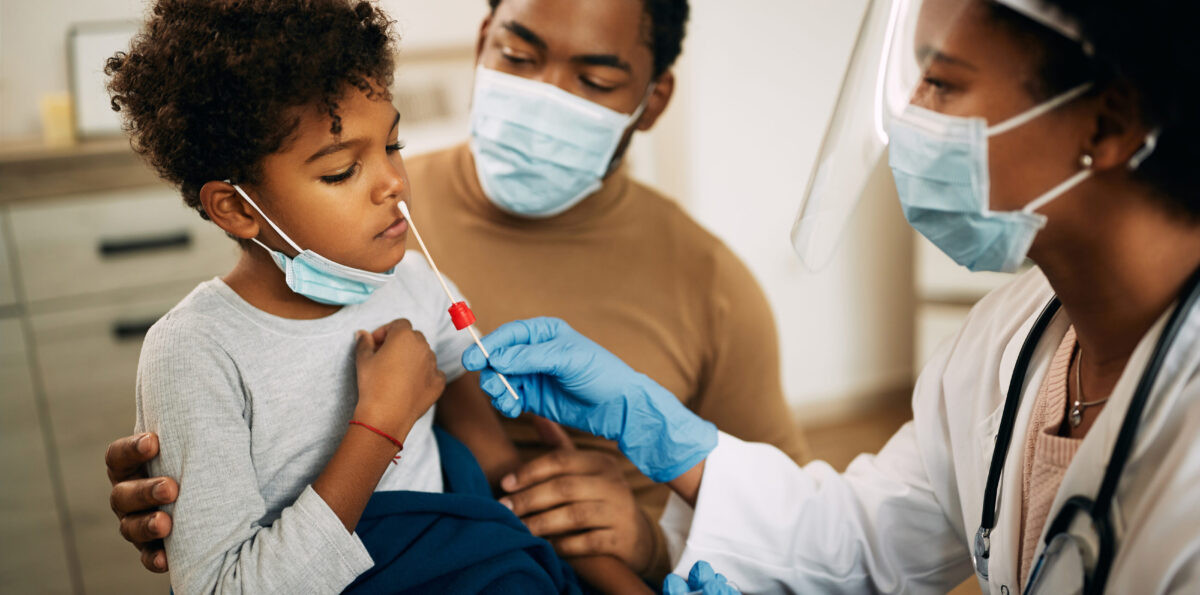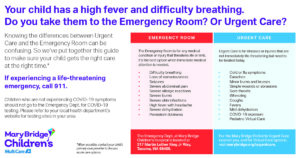What to do if your child is exposed to COVID-19

Children across the region strapped on their backpacks and returned to school this week as holiday breaks came to an end. Yet classes are resuming in the midst of a new surge in COVID-19 cases largely fueled by the omicron variant. What steps should you take if your child is showing symptoms or needs to get tested?
COVID-19 is spreading rapidly among children
Most children with COVID-19 experience mild symptoms, or no symptoms at all, but the virus is affecting children at significantly greater rates now than last year. According to the American Academy of Pediatrics, there were nearly 199,000 reported cases of children with COVID-19 the week ending Dec. 23 — a 50 percent increase in weekly cases compared to the beginning of December.
“With the return of school, we are very concerned about the increased exposure and risk for children, especially those who cannot get vaccinated,” said Mary Fairchok, MD, medical director of pediatric infectious diseases at Mary Bridge Children’s Hospital. “In addition to COVID-19 and the long-term effects we’re seeing in children, we’re also worried about other viruses like RSV (respiratory syncytial virus) and seasonal flu at this time of the year.”
The spike in COVID-19 coupled with rising pediatric hospital admissions make it especially important to what to do and where to get care if your child is exposed to someone with COVID-19, needs a test, or shows virus symptoms.
What to do if your child is exposed to someone with COVID-19
- Talk to your child’s pediatrician and get tested three to five days after the known exposure
- Isolate at home and avoid contact with other family members, if possible.
- Watch for and monitor any COVID-19 symptoms.
- Stay hydrated and rest.
Where to get tested or treated for mild symptoms
If your child needs a COVID-19 test and is not showing symptoms, or only has mild symptoms, do not go to the emergency department.
In order to care for patients truly requiring emergency treatment, we urge families whose children are not seriously sick to seek other options, including community testing sites available through the Tacoma-Pierce County Health Department. In addition to taking valuable resources away from patients needing immediate care, visiting the emergency department when your child isn’t showing any symptoms — or who only have mild symptoms — could increase the risk of additional exposures to others.
In addition to community testing sites, you can also complete a virtual urgent care visit with Mary Bridge Children’s providers from the comfort of your home. Providers can assess your child over video and provide recommendations for next steps. Virtual visits are billed through insurance the same way as traditional visits — through insurance or self-pay if you do not have insurance.
Whether you opt for a virtual or in-person visit, most fevers, ear infections, coughs, rashes, allergies and minor injuries can be treated through urgent care. Appointments are required for both in-office urgent care and virtual urgent care visits.
When to seek emergency care
Mary Bridge Children’s Emergency Department is open and ready to treat your child with the latest medical technology and services. Do not delay emergency care if your child shows any of the following:
- Severe respiratory distress or problems breathing
- Life-threatening trauma, including injuries from car accidents
- Complex fractures or broken bones
- Head injuries or chest pain
- Severe abdominal pain
- High fever
- Dehydration
- Heavy bleeding
- Other emergency conditions
“The best protection against the virus is the vaccine,” Dr. Fairchok said. “It’s also really important to continue to be diligent with masking, hand washing and maintaining physical distance from others in crowded areas as we face yet another highly contagious COVID-19 variant.”
For more information about COVID-19, including vaccines, visit MultiCare’s COVID-19 resource page. If your child needs a pediatrician, visit the Mary Bridge Children’s provider page to locate a provider near you.
Editor’s note: This article was originally published Sept. 15, 2021, and updated Jan. 3, 2022.
